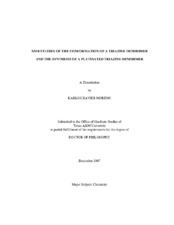| dc.description.abstract | A general picture of dendrimer conformation has appeared through studies of various dendrimer systems. Though the studies define some conformational abilities of a dendrimer, the studies are only able to examine one portion of the general picture. NMR studies of a generation three melamine dendrimer with unique NMR signatures from core to periphery describes most, if not all, of the general concepts of dendrimers in one system. A generation three melamine dendrimer was synthesized by a convergent route using diamines identified from competition reactions towards a monochlorotriazine. The cyclic monoamines surveyed displayed a relative reactivity range of 40x, expanding the previously identified series to a range of 320x. Azetidine is 40x more reactive than the cyclic, nine-membered ring (C8H17N), and 320x more reactive than benzyl amine. Sterics and pKa values explain the differences in reactivity of the cyclic monoamines. Differences in the nucleophilicity of the amine groups consisting of 2-aminoazetidine, 2-aminopyrrolidine, and 4-aminopiperidine are 180x, 70x and 20x, respectively. One-dimensional NMR spectra of the exchangeable NH region show that the dendrimer supports a rich rotamer population. Observations of the data show that the rotamer populations change from a preferred extended conformation to a more closed conformation, indicative of sterics being a driving force of conformational architecture. Variable temperature NOESY studies show that the peripheral groups backfold into the interior of the dendrimer in DMSO- d6. The backfolding can be removed by changing the solvent to either CDCl3 or CD3OD. Variable temperature (VT) coefficients measured for the exchangeable NH protons implies that solvent may be excluded from the interior of the dendrimer. Proton relaxation studies provide evidence that the dendrimer tumbles slowly in solution, and the periphery moves more freely than the interior. Synthesis towards the attachment of carboplatin-like peripheral groups on a generation three dendrimer was unsuccessful. A diethyl malonate unit was attached to the periphery of the dendrimer followed by capping with 4-aminomethylpiperidine. Hydrolysis of the esters and treatment with activated platinum led to a black precipitate product. Two alternate routes of achieving the desired platinated dendrimer are described. | en |


